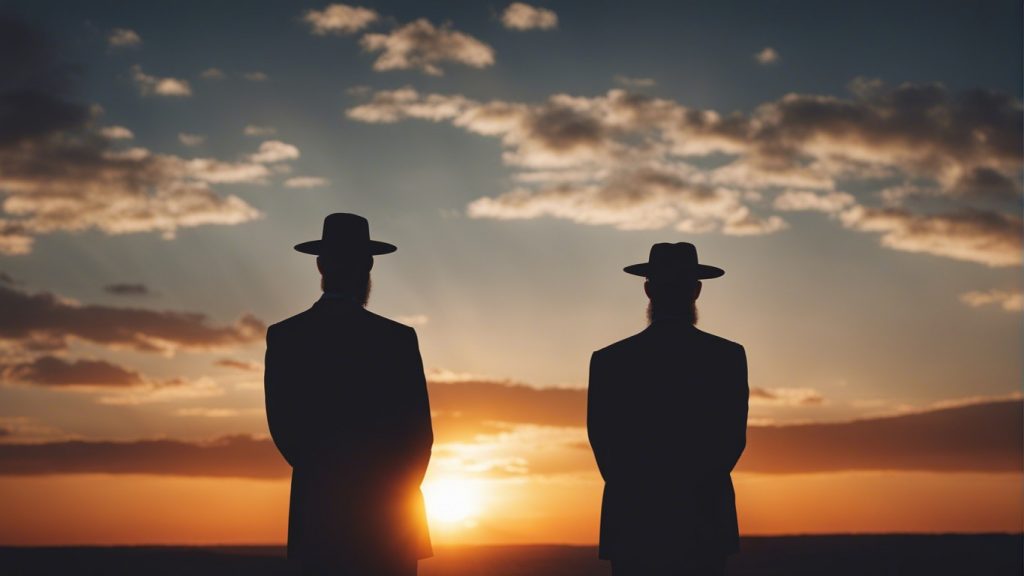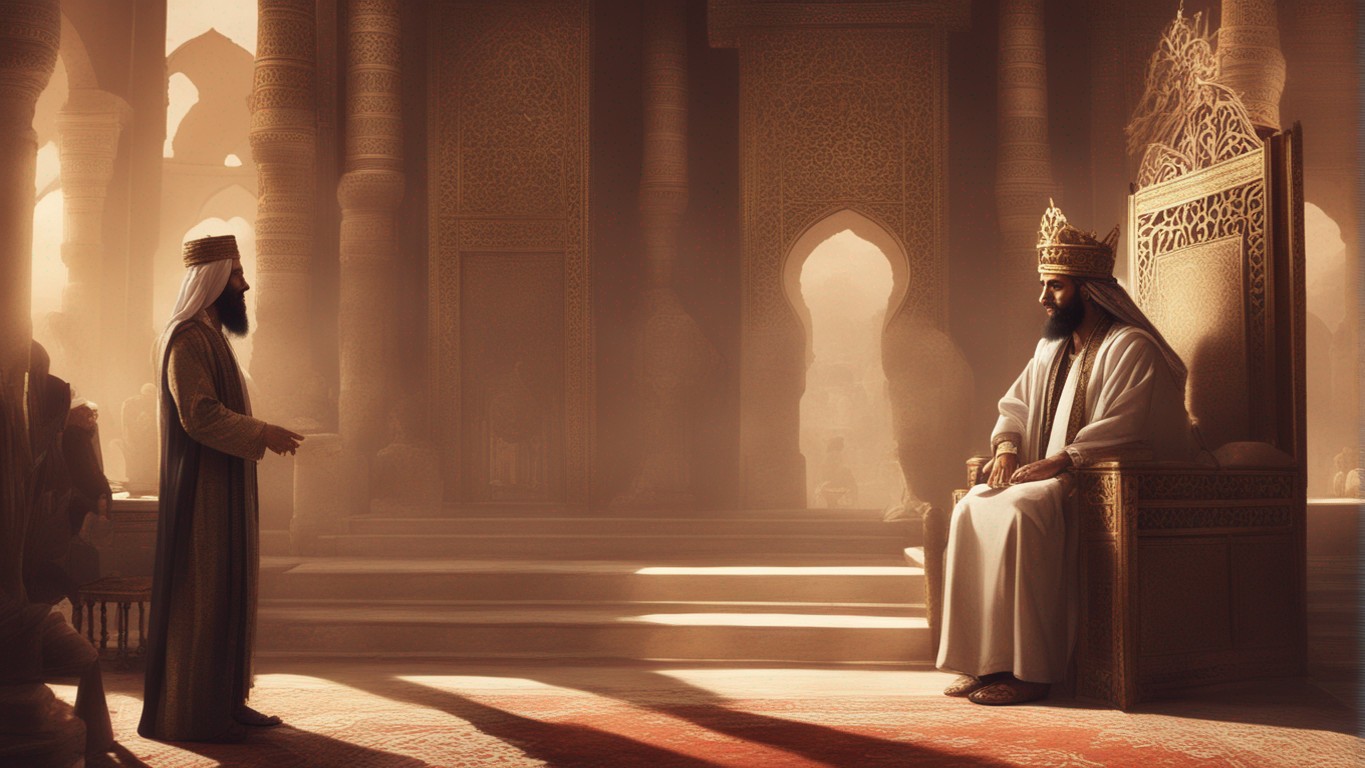In the book of Chronicles, God is depicted as the reigning King of Israel who rules by the Torah. In the end when we are living in God’s universal Kingdom, all nations will acknowledge God as King. For now, we are granted access to come before the King in prayer. At times of prayer, we should truly understand that we are standing before the Great King. This reality is punctuated by the posture taken by Mizrahi Jews, Orthodox Christians and Muslims when standing for prayer.
Jews from Eastern (Mizrahi) lands will often place the left hand at the top of the belly beneath the sternum. The right hand covers the left and the left hand clutches the thumb of the right. Christians lie their hands across the chest, right over left and Muslims place the right hand directly over the left at the top of the belly. The posture is fairly consistent across the board, but what’s it all about. This is the posture taken when standing before a King.
In the generation of Christ this reality was easy to comprehend. Each worshiper knew what it meant to stand before a King. Jesus said in Mark 11:25 when you “stand praying” forgive others so that your Father in Heaven will forgive you.
Paul talks about Jesus’ governance as Christ and King, but he magnifies the place of the Creator by emphasizing the submission of the Son to the Father. In 1 Corinthians 15:24-28 he explains,
“Then the end will come, when He (Jesus) hands over the kingdom to God the Father after he has destroyed all dominion, authority, and power. For he must reign until he has put all his enemies under his feet. The last enemy to be destroyed is death. For he “has put everything under his feet.” Now when it says that “everything” has been put under him, it is clear that this does not include God himself, who put everything under Christ. When he has done this, then the Son himself will be made subject to him who put everything under him, so that God may be all in all.”
Prayer expresses our faith in God and shows that we are dependent on Him. We are given the ability to make our requests before the King, and in Matthew 6:9-15 Jesus instructed us on how we should do that:
This, then, is how you should pray: Our Father in heaven, hallowed be your name, your kingdom come, your will be done, on earth as it is in heaven. Give us today our daily bread. And forgive us our debts, as we also have forgiven our debtors. And lead us not into temptation, but deliver us from the evil one. For if you forgive other people when they sin against you, your heavenly Father will also forgive you. But if you do not forgive others their sins, your Father will not forgive your sins.
If you look closely at this prayer, it becomes clear that the focus in prayer should be the Creator. Prayer is the order of the Kingdom. Our King is kind and we have the ability to make requests, but those requests must align with the will of God. When we pray as Christ has instructed us, we make a statement and agree that God’s name is holy and sanctified; we ask for His Kingdom to blossom here in this world. We request that God’s will be done here on this earth as it is in heaven. This implies that God’s will is not always done here in this earth. We ask for God to forgive us as we show forgiveness to others. We ask for justice, measure for measure. In the “Our Father” we pray for mercy as well, for ourselves and others. Jesus taught that if we do not forgive others, the King will not forgive us.
Importance of Prayer and Drawing Near To God
There are times we pray individually, and times we pray as a community. Prayer is the service of the heart. We may communicate individually with God anytime during the day, but there are also appointed times each day that we can pray together as a community. During the time of the Temple the sacrifices (korbanot) were used to draw near to God. The word “korban” means “to draw near” and this drawing near took place at specific times as is clear from the behavior of the Apostles in the book of acts.
To help understand the importance of prayer times, there are appointed festivals throughout the year, and each one of these special days includes specific prayers. The appointed times are a rehearsal of the interaction between God, the children of Israel, and the entire world. Each appointed time celebrates a specific occasion that is on God’s timeline, and there is a rhythm to it all that aligns with creation itself. Prayer and drawing close to God is a part of the natural cycle created by God. It happens every day, every week, and throughout the whole year.
In Numbers 28:1-2 it says, “The Lord said to Moses, give this command to the Israelites and say to them: Make sure that you present to me at the appointed time my food offerings, as an aroma pleasing to me.”
A disciple is to imitate his rabbi in all things. Our rabbi Jesus was an observant Jew, He prayed during these appointed times, like all observant Jews. Jews were praying three times a day long before the birth of Christ. Jewish tradition insists and scripture seems to support the idea that it was Ezra who canonized formal prayer almost 500 years before the times of the Apostles, shortly after the Jewish return from Babylonian captivity.
Ezra led the Jewish people in:
- The work that led to rebuilding the Temple.
- Gathering the people together to read the Torah publicly. He would read at different times during the week and during the afternoon service on the Sabbath.
- He led the Jews back to embracing the Sabbath and observing the festivals (appointed times).
- He also established the Great Assembly, which was responsible for forming the liturgy of prayer that is prayed three times a day and on every festival.
Even before the time of Ezra, the Bible tells us that both the Prophet Daniel and King David made a regular practice of praying three times a day. Daniel 6:10 explains
“And in his upper room, with his windows open toward Jerusalem, he knelt down on his knees three times that day, and prayed and gave thanks before his God, as was his custom since early days.”
It says in Psalms 55:16-17, “As for me, I will call upon God, and the Lord shall save me. Evening and morning and at noon I will pray, and cry aloud, and He shall hear my voice.”
Many of the prayers that were used in the Temple are preserved as Psalms. Many of these were written by King David and his Elders in preparation for the Temple service. Every morning the Levites would sing a song of the day which is a specific Psalm composed by David.
Importance of Prayer During Specific Times During the Day
The Apostle Peter prayed three times a day. In Acts 2:15, he prayed with the church at the “third hour” (9 am). In Acts 3:1, Peter and John went up together to the temple at the hour of prayer, the “ninth hour” (3 pm). In Acts 10:9, Peter went up to housetop to pray at the “sixth hour” (noon). These times clearly reflect the usual and expected rhythms of biblical prayer.
Before the time of Christ, there was an order (siddur) of prayer that was memorized through daily practice. With the creation of the printing press, about 500 years ago, an actual prayer book, called a siddur, was published for the first time. There are prayers written for weekdays, the Sabbath, and for each festival. Ironically, or maybe not so ironically, a tradition exists that Paul and Peter actually composed the core prayers of Rosh Hashanah and Yom Kippur still used today.

At the heart of daily Jewish prayer lies the Amidah (The Standing Prayer). It is said in the slightest whisper or just the motion of the lips. As described above, one praying the Amidah does so with the conciseness that he or she is standing directly be the King of the universe. Its not easy. Jews bow several times during the Amidah, highlighting this reality. The prayer has nineteen blessings. It begins with three blessings of praise and concludes with three blessings of thanksgiving. The blessings placed between these two book ends are adjusted for holidays and special occasions.
Generally, they appear in the order given below:
- Blessing for the Covenant that God made
- Praise for miracles and the resurrection
- Praise for the holiness of God’s name
- Prayer for discernment
- Prayer for repentance
- Prayer for forgiveness
- Prayer for redemption
- Prayer for healing
- Prayer for harvest
- Prayer for gathering the exile
- Prayer for justice
- Prayer for punishment for the wicked
- Prayer for the righteous
- Prayer for rebuilding Jerusalem
- Prayer for the restoration of the Davidic king and the return of Yeshua
- Prayer for acceptance
- Thanksgiving for the Temple Service
- Thanksgiving for God’s goodness
- Thanksgiving for peace
A great resource to learn about Jewish prayer as performed by the early Jewish saints and those who have adopted their practice is a book called “First Steps in Messianic Jewish Prayer” by Aron Eby.
Chabad.org also has the Amidah here. If you are already familiar with this prayer and would like to download a free app, we recommend an app called SiddurMe. At time of this post we only found available for Apple Devices.
If one takes the time to learn the Amidah and incorporate it into devotional times or makes the choice to pause during the day to pray like our first teachers, they will certainly draw closer to God and see tremendous spiritual growth.

